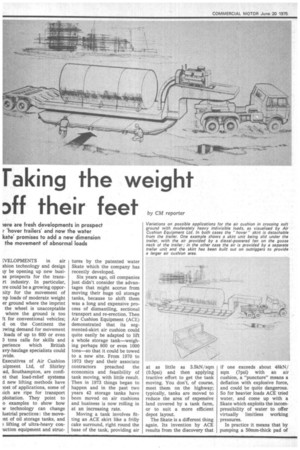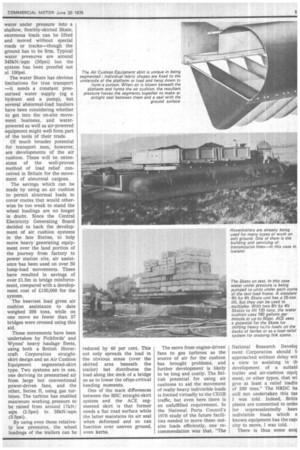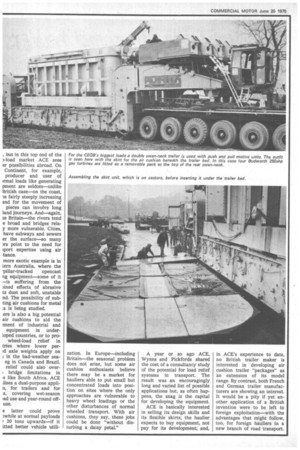Taking the weight
Page 52

Page 53

Page 54

If you've noticed an error in this article please click here to report it so we can fix it.
Dff their feet by CM reporter :VELOPMENTS in air shion technology and design ty be opening up new busiss prospects for the transrt industry. In particular, ?re could be a growing opporaity for the movement of np loads of moderate weight er ground where the imprint the wheel is unacceptable where the ground is too It for conventional vehicles; d on the Continent the awing demand for movement loads of up to 600 or even D tons calls for skills and perience which British ivy-haulage specialists could wide.
Executives of Air Cushion uipment Ltd, of Shirley ad, Southampton, are confiat that load-relief systems d new lifting methods have lost of applications, some of Lich are ripe for transport ploitation. They point to o examples to show how w technology can change lustrial practices : the moveTit of oil storage tanks, and ? lifting of ultra-heavy conuction equipment and struc tures by the patented water Skate which the company has recently developed.
Six years ago, oil companies just didn't consider the advantages that might accrue from moving their huge oil storage tanks, because to shift them was a long and expensive process of dismantling, sectional transport and re-erection. Then Air Cushion Equipment (ACE) demonstrated that its segmented-skirt air cushion could quite easily be adapted to lift a whole storage tank—weighing perhaps 800 or even 1000 tons—so that it could be towed to a new site, From 1970 to 1973 they and their associate contractors preached the economics and feasibility of tank moving, with little result. Then in 1973 things began to happen and in the past two years 42 storage tanks have been moved on air cushions and business is now rolling in at an increasing rate.
Moving a tank involves fitting an ACE skirt like a frilly cake surround, right round the base of the tank, providing air at as little as 3.5kN/sqm (0.5psi) and then applying tractive effort to get the tank moving. You don't, of course, meet them on the highway; typically, tanks are moved to reduce the area of expensive land covered by a tank farm, or to suit a more efficient depot layout.
The Skate is a different thing again. Its invention by ACE results from the discovery that if one exceeds about 48kN/ sqm (7psi) with an air cushion, a "puncture" means a deflation with explosive force, and could be quite dangerous. So for heavier loads ACE tried water, and come up with a Skate which exploits the incompressibility of water to offer virtually limitless working pressures.
In practice it means that by pumping a 50mm-thick pad of water under pressure into a shallow, flexibly-skirted Skate, enormous loads can be lifted and moved without special roads or tracks—though the ground has to be firm. Typical water pressures are around 345kN/sqm (50psi) but the system has been proofed out at 100psi.
The water Skate has obvious limitations for true transport —it needs a constant pressurised water supply (eg a hydrant and a pump), but several abnormal-load hauliers have been considering whether to get into the on-site movement business, and waterpowered as well as air-powered equipment might well form part of the tools of their trade.
Of much broader potential for transport men, however, are developments of the air cushion. These will be extensions of the well-proven method of load relief conceived in Britain for the movement of abnormal cargoes.
The savings which can be made by using an air cushion to permit abnormal loads to cover routes that would otherwise be too weak to stand the wheel loadings are no longer in doubt. Since the Central Electricity Generating Board deoided to back the development of air cushion systems in the late Sixties, to help move heavy generating equipment over the land portion of the journey from factory to power station site, air assistance has been used on over 50 lump-load movements. These have resulted in savings of over £1.5m in bridge reinforcement, compared with a development cost of E100,000 for the system.
The heaviest load given air cushion assistance to date weighed 399 tons, while on one move no fewer than 37 bridges were crossed using this aid.
These movements have been undertaken by Pickfords' and Wynns' heavy haulage fleets, using both a British Hovercraft Corporation straightskirt design and an Air Cushion Equipment segmented-skirt type. Two systems are in use, one deriving its pressurised air from large but conventional power-driven fans, and the other, Series II, using gas turbines. The turbine has enabled maximum working pressure to be raised from around 17kN,/ sqm (2.5psi) to 38kINI/sqm (5.5psi).
By using even these relatively low pressures, the wheel loadings of the trailers can be reduced by 40 per cent. This not only spreads the load in the obvious sense (over the skirted area beneath the trailer) but distributes the load along the deck of a bridge so as to lower the often-critical bending moments.
One of the main differences between the BHC straight-skirt system and the ACE segmented skirt is that former needs a flat road surface while the latter maintains its air seal when deformed and so can function over uneven ground, even kerbs. The move from engine-driven fans to gas turbines as the source of air for the cushion has brought problems, and further development is likely to be long and costly. The British potential for using air cushions to aid the movement of really heavy indivisible loads is limited virtually to the CEGB traffic, but even here there is an unfulfilled requirement. In the National Ports Council's 1970 study of the future facilities needed to move these outsize loads efficiently, one recommendation was that. "The National Research Develor ment Corporation should b approached without delay wit a view to assisting in th development of a suitabl trailer and air-cushion equii ment, or other types, that wi give at least a relief loadin of 200 tons." The NRDC ha still not undertaken this tas I was told. Indeed, Britis plants are committed to ordei for unprecedentedly heav indivisible loads which n known equipment has the cap; city to move, I was told.
There is thus some SCOr , but in this top end of the )-load market ACE sees er possibilities abroad. On Continent, for example, producer and user of ■ rmal loads like generating pment are seldom—unlike British case—on the coast, le fairly steeply increasing and for the movement of pieces can involve long land journeys. And—again, te Britain—the rivers tend e broad and bridges relay more vulnerable. Cities, have subways and sewers er the surface—so many )rs point to the need for ;port expertise using air tance.
more exotic example is in tern Australia, where the pillar-tracked opencast ng equipment—some of it —is suffering from the )ined effects of abrasive tz dust and soft, unstable nd. The possibility of subting air cushions for metal :s is being studied.
ere is also a big potential air cushions to aid the !ment of industrial and equipment in underloped countries, or to pro wheel-load relief in tries where lower per421 axle weights apply on ; in the bad-weather sea eg in Canada and Brazil.
relief could also over! bridge limitations in s like South Africa. ACE lises a dual-purpose applin, for trailers and for .s, covering wet-season lad use and year-round offuse.
e latter could prove -iwhile at normal payloads r 20 tons upwards—if it itted better vehicle utili zation. In Europe—including Britain—the seasonal problem does not arise, but some air cushion enthusiasts believe there may be a market for hauliers able to put small but concentrated loads into position on sites where the only approaches are vulnerable to heavy wheel loadings or the other disturbances of normal wheeled transport. With air cushions, they say, these jobs could be done "without disturbing a daisy petal." A year or so ago ACE, Wynns and Pickfords shared the cost of a consultancy study of the potential for load relief systems in transport. The result was an encouragingly long and varied list of possible applications but, as often happens, the snag is the capital for developing the equipment.
ACE is basically interested in selling its design skills and its flexible skirts; the haulier expects to buy equipment, not pay for its development; and, in ACE's experience to date, no British trailer maker is interested in developing air cushion trailer "packages" as an extension of its model range. By contrast, both French and German trailer manufacturers are showing an interest. It would be a pity if yet another application of a British invention were to be left to foreign exploitation—with the advantages that might follow, too, for foreign hauliers in a new branch of road transport.




























































































































































